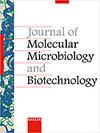Evidence of Interruption of the comM Gene in a Large Series of Clinical Isolates of Multidrug-Resistant Acinetobacter baumannii
IF 1.2
Q2 Biochemistry, Genetics and Molecular Biology
引用次数: 7
Abstract
Recent studies have recognized the ATPase-encoding comM gene as a hot spot for the integration of Acinetobacter baumannii resistance islands (RIs). Despite the circulation of high numbers of multidrug-resistant A. baumannii (MDR-AB) isolates in Middle East countries, no information is available about the interruption of comM and subsequent transposition into comM in isolates belonging to the global clones (GC) GC1, GC2, or GC3. In this study 401 A. baumannii isolates from hospitals in Tehran, Iran, were included. The resistance profile was determined by disc diffusion against 22 antibiotics. PCR was used to assess the GC type, presence of the comM gene, and the boundary junctions (J1 and J2) of RIs. Most of the MDR-AB isolates (384 of 388; 98%) and more than half of the susceptible A. baumannii isolates (9 of 13; 69%) had interrupted comM gene-carrying integrative elements. Among the isolates tested, 57 belonged to GC1, 86 to GC2, and 8 to GC3. A set of 250 isolates showed distinct patterns of allele-specific PCR for ompA, csuE, and blaOXA-51-like genes. All but 2 of the GC1 isolates and 2 of the GC2 isolates contained interrupted comM genes. Four A. baumannii isolates harbored intact comM, but were multiply resistant to antibiotics. This study demonstrated that the comM gene is targeted by transposons in Iranian MDR-AB isolates belonging to different GCs. The data also showed that the carriage of interrupted comM is not exclusive to MDR isolates of A. baumannii.大量耐多药鲍曼不动杆菌临床分离株中comM基因中断的证据
近年来的研究发现,编码atpase的comM基因是鲍曼不动杆菌耐药岛(RIs)整合的热点。尽管在中东国家存在大量耐多药鲍曼不动杆菌(MDR-AB)分离株,但没有关于全球克隆(GC) GC1、GC2或GC3分离株的comM中断和随后转位为comM的信息。本研究纳入了来自伊朗德黑兰医院的401株鲍曼不动杆菌分离株。采用圆盘扩散法测定对22种抗生素的耐药性。PCR检测GC类型、comM基因是否存在以及RIs的边界连接(J1和J2)。大多数MDR-AB分离株(388株中的384株;98%)和半数以上的易感鲍曼不动杆菌分离株(13个中的9个;69%)携带comM基因的整合元件中断。其中GC1型分离株57株,GC2型分离株86株,GC3型分离株8株。一组250个分离株的ompA、csuE和blaoxa -51样基因的等位基因特异性PCR显示出不同的模式。除2株GC1和2株GC2外,其余均含有中断的comM基因。四个鲍曼不动杆菌分离株携带完整的comM,但对抗生素产生多重耐药。本研究表明,在属于不同gc的伊朗MDR-AB分离株中,comM基因被转座子靶向。数据还表明,携带中断的comM并不仅限于MDR鲍曼不动杆菌分离株。
本文章由计算机程序翻译,如有差异,请以英文原文为准。
求助全文
约1分钟内获得全文
求助全文
来源期刊

Journal of Molecular Microbiology and Biotechnology
生物-生物工程与应用微生物
CiteScore
3.90
自引率
0.00%
发文量
0
审稿时长
>12 weeks
期刊介绍:
We are entering a new and exciting era of microbiological study and application. Recent advances in the now established disciplines of genomics, proteomics and bioinformatics, together with extensive cooperation between academic and industrial concerns have brought about an integration of basic and applied microbiology as never before.
 求助内容:
求助内容: 应助结果提醒方式:
应助结果提醒方式:


